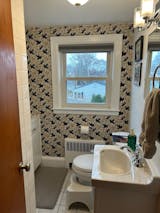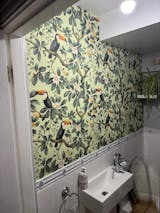How To?
To ensure that your wallpaper fits perfectly, simply measure the complete wall's width and height. We create your wallpaper according to your exact specifications, so we suggest adding 6-10 cm (2.5-4 inches) to both the width and height measurements to allow for any potential assembly errors. For guidance on measuring different wall types, please refer to the examples provided below.

Standard Walls
Measure the complete wall's width and height accurately. We create your wallpaper based on your precise specifications, so we advise adding 6-10 cm (2.5-4 inches) to both the width and height measurements to accommodate for assembly errors. Please ensure that you double-check your measurements to ensure accuracy.
Sloped Walls
Measure the highest and widest points of the wall, while disregarding any slopes. The mural will be printed and delivered as a complete rectangle or square, with the sloped portion removed during installation. To account for any installation errors, we suggest adding 6-10 cm (2.5-4 inches) to both the width and height measurements.

Pitched Walls
Measure the longest part of the wall for both the width and height. The mural will be created as a complete rectangle or square, and the sloped part will be removed during installation. To allow for any potential installation errors, we suggest adding 6-10 cm (2.5-4 inches) to both the width and height measurements.

Walls with Doors, Windows, or Obstacles
To measure walls with doors, windows, or other obstacles, measure the complete wall's width and height. During installation, all obstacles will be removed. We create your wallpaper based on your exact specifications, so we recommend adding 6-10 cm (2.5-4 inches) to both the width and height measurements to allow for any installation errors.

Staircases
When measuring a staircase wall, identify the highest and lowest points of the wall for the height measurement, and for the width measurement. The sloped parts will be removed during installation. To allow for any installation errors, we suggest adding 6-10 cm (2.5-4 inches) to both the width and height measurements.

Multiple Walls For Murals
To measure multiple walls for murals, measure the width of each wall and combine the measurements when placing your order. Add 5 cm (2 inches) per wall as a safety margin. Then, measure the height, starting from the highest point and adding 6-10cm (2.5-4inches) to the measurement to accommodate for any installation errors. There's no need to order the mural in two separate parts.
***Note- Each wallpaper or mural order is custom printed with great care and effort. We cannot guarantee color accuracy for separately placed orders. To ensure that you have enough material to cover your project, we highly recommend ordering approximately 2.5-4 inches extra than your calculated amount. If you need assistance with your order, please do not hesitate to contact us.
Installation of Peel & Stick Wallpaper
The self-adhesive, high-quality textile material allows for easy installation and multiple uses. The Peel & Stick wallpaper features a fabric base with a factory-coated adhesive layer, making it suitable for walls, furniture, and doors. The vibrant colors are realistic and vivid, and the material leaves no residue when removed. It’s fully repositionable, semi-matte, and has a linen-like texture, all without the need for glue.
Tools and Equipment
- Primer
- Wallpaper brush
- Pencil
- Utility knife
- Measuring tape
- Spirit level or laser level
1. Wall Preparation
Ensure the wall is smooth, dry, clean, and primed with an appropriate primer. Remove any old paint, varnish, or wallpaper remnants. Allow freshly painted or plastered walls to dry for three weeks. Sand ceramic, latex, or poorly adhering surfaces before priming. Fill holes and gaps, and remove sockets and baseboards. Proper wall preparation is key for smooth installation.
2. Checking the Wallpaper
Unroll the wallpaper on a clean surface to ensure all rolls are received and the pattern matches. Check for defects like deformations, discolorations, or dimensional issues greater than 1%. If defects are found, file a complaint before installing. Each roll is numbered for easy installation.
Note: No claims on defects after installation!
3. Plan the Wallpaper on the Wall
Measure and draw a vertical line on the wall. If the wall is not perfectly straight, shift the line 2.5 cm / 1 inch to the left. This ensures accurate placement when starting from the left.
4. Wallpaper Installation
Start from the top, slowly unrolling the wallpaper and separating the backing from the adhesive. Use a wallpaper smoother to remove air bubbles. Apply each subsequent strip edge-to-edge, aligning the pattern perfectly. Once finished, trim any excess wallpaper with a utility knife, pressing carefully to avoid tearing.
Installation of Eco & PRO-Vinyl Wallpaper Series
Pro-Vinyl Wallpapers are high-quality, durable vinyl materials with a non-woven backing. Pro-Vinyl wallpapers are installed using heavy-duty wallpaper adhesive. For North America, we recommend using Roman Pro-773 or Shur-Tac Wallcovering Adhesive. Both are strong, reliable options for vinyl wallpaper installation. Thanks to the unique texture of the material, the print on non-woven wallpapers stands out with vibrant colors and depth, making the patterns exceptionally striking. The materials have been approved by the National Institute of Hygiene.
Tools and Equipment
- Primer
- Heavy-duty adhesive for non-woven wallpapers
- Adhesive mixer
- Brush and roller for adhesive
- Clean, damp cloth
- Wallpaper seam roller
- Wallpaper smoother
- Pencil
- Utility knife
- Measuring tape
- Level or laser level
1. Wall Preparation
Ensure the wall is smooth, dry, clean, and primed with an appropriate primer. Remove old paint or wallpaper, fill holes, and allow new paint or plaster to dry for three weeks. Sand any rough surfaces before priming.
2. Inspecting the Wallpaper
Unroll the wallpaper and check for defects or pattern mismatches. Ensure each roll is free from issues like discoloration or dimensional differences. If there are defects, file a complaint before installation.
Note: No claims on defects after installation!
3. Planning the Wallpaper
Measure and draw a vertical line on the wall using a level. Shift the line 2.5 cm / 1 inch to the left to account for the wallpaper’s edge overlap.
4. Applying Glue
Apply glue only to the wall using a roller or brush. Spread an even, thin layer, covering just the area for the current strip, extending about 5 cm / 2 inches beyond the wallpaper edge.
5. Installing the Wallpaper
Start from the top, unrolling the wallpaper and smoothing out air bubbles with a tool or roller. Align each strip edge-to-edge, ensuring pattern consistency. Wipe off any glue with a damp cloth. Trim excess wallpaper with a utility knife.


